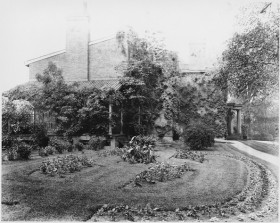The front lawn of The Grange, now known as The Grange Park, was central to Grange activities. This was the site for many garden parties, church school picnics and even a royal visit. Originally, a path ran up to the front steps, flanked by an oval drive for carriages. The house stood on raised ground with terraces, as it does today. Around it was a mix of open spaces, stands of trees and flower gardens. Behind the house were vegetable and fruit gardens and, farther north, an orchard.
Several images of The Grange show a domed glass conservatory on the east side of the house, which would have been filled with plants readily available from catalogues. One 1827 catalogue advertised 79 varieties of apples, ornamental trees, as well as a wide variety of shrubs, flowers and greenhouse plants. We know that there was an orchard house on the property growing peaches, nectarines and grapes. William Boulton won prizes at the 1844 Toronto Horticultural Society Show for geraniums, roses, greenhouse plants and pansies. The gardener, John Gray, named a geranium he developed Pelargonium Boultonianum after the Boultons.
With the sale of the southern part of the property in the mid-1800s, a new entrance to The Grange was created, which included a lodge — home to William Chin, the butler, and his family. Other buildings included a stable, a root house, a tool house and a drive shed. Later in the century, cottages for married servants were also erected.
